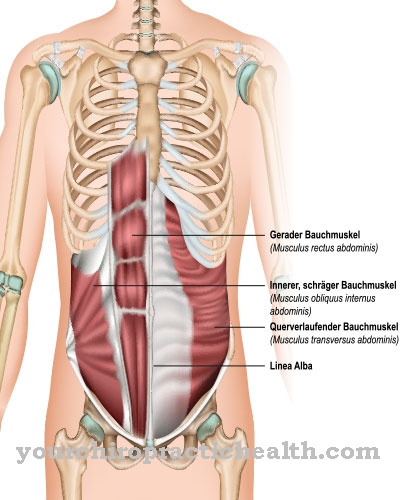Also called Osteopoicilia, Osteopathia condensans disseminata or Spotted bones known Osteopoicilosis is a form of bone malformation. It occurs extremely rarely and is benign. The international classification according to ICD-10 is Q78.8.
What is osteopoicilosis?

© eranicle - stock.adobe.com
Osteopoicilosis is characterized by compaction or hardening in the bone tissue. The Hamburg surgeon and radiologist Heinrich Albers-Schönberg described osteopoicilosis for the first time in 1915. The name was given by two French authors as early as 1917.
The densification occurs primarily in the pelvic bones, the tubular bones, and the tarsal and hand bones. They are mainly found near blood vessels in the growth zones of the bones, the metaphyses. However, the end pieces, medically called epiphyses, can also be affected. Oval, round and also elongated densities can be observed.
The thickness varies from a millimeter to a little more than two centimeters. Often the compressions are arranged along a straight chain. In osteopoicilosis, almost the entire skeleton is affected in stages. The finger and carpal bones are most likely to occur. The thickening in the calf and tibia is rare. The vertebrae, ribs and skull are almost never affected.
causes
The origin and cause of osteopoicilosis has not yet been clarified. Initially, an inactivated remodeling of the lamellar bone to the cancellous bone was suspected. However, no proof for this thesis has yet been provided. In the meantime there is speculation about a genetic defect. However, there is no clear evidence of this either. However, this theory would explain the results of several studies.
They found a frequency of occurrence among family members, which could indicate an autosomal dominant inheritance. However, the possible sporadic occurrence of osteopoicilosis and its detection in the fetal bone could also be explained by a genetic defect.
Disorders of the mineral metabolism, on the other hand, could undoubtedly be excluded as the cause. The same applies to possible increased bone remodeling in these regions. Corresponding indications in a skeleton scintigraphy cannot be found.
Symptoms, ailments & signs
Osteopoicilosis proceeds without the appearance of symptoms. The around 400 cases known worldwide to date are incidental findings as well as findings made in studies on family members of those affected. Since there are no noticeable signs of bone compression, the exact number of cases is in the dark.
By looking through thousands of x-rays from a Vienna accident hospital, researchers have already tried to determine a possible frequency. Still, the language ranges from 0.1 cases per million people to about twelve cases per 100,000. From the known cases and studies it can be seen that men are more often affected than women. The amount of foci in the bones fluctuates.
But even in spite of the great density of the herd, as it is usually found in the pelvic bones, there are no signs of osteopoikilosis. There are no relevant laboratory changes, nor do slight or severe fractures occur at the same time. In the same way, the compaction is irrelevant in the healing of fractures caused by other means.
Diagnosis & course of disease
Osteopoikilosis can only be diagnosed through radiological examinations. Even with a scintigraphy of the skeleton, the densities remain invisible. They appear to appear in childhood, develop as they grow up, and then stagnate. It has seldom been observed that the densities dissolve again or their number decreases.
Complications
Because of osteopoikilosis, those affected suffer from various bone malformations. These malformations can significantly restrict the patient's everyday life and make it more difficult, so that osteopoikilosis is usually also associated with a significant reduction in quality of life. The patient's bones are less dense and can easily break even with light loads or impacts.
For this reason, patients with osteopoikilosis need special protection against accidents and dangerous sports. Furthermore, pain can also occur in some cases. As a result, fractures heal less well due to osteopoicilosis, so that a long recovery process is usually necessary. However, life expectancy itself is not influenced or otherwise reduced due to illness.
Furthermore, child development can possibly be restricted, so that those affected suffer from various complaints even in adulthood. If a tumor is responsible for the osteopoicilosis, it can possibly be removed. Furthermore, the patients often suffer from joint problems and in some cases are therefore dependent on the help of other people in their everyday lives. Psychological stress can also occur and have a negative effect on the patient's quality of life.
When should you go to the doctor?
If hardening occurs in the bone area, a doctor should be consulted. Osteopoikilosis manifests itself through various deformations that can occur on the arms, legs, shoulders, the sternum and the spine. The benign bone malformations are usually noticed in early childhood. Parents who notice such signs in their child should consult their pediatrician. Otherwise, the bone changes can increase and form malignant degeneration.
To date, osteopoicilosis cannot be treated, but it requires monitoring so that the aforementioned degenerations can be treated at least symptomatically. Affected children may also need physiotherapy treatment. Since osteopoikilia is a genetic disease, a diagnosis can be made immediately after birth. If there are already cases of the disease in the family, the necessary screenings should be carried out. The orthopedist or oncologist is responsible. The regular check-ups can be carried out in the hospital and often in the doctor's office.
Therapy & Treatment
Treatment of osteopoikilosis is not necessary and, based on current knowledge, is simply not possible. In the event of an incidental finding, however, it should always be clarified that it is indeed osteopoikilosis and not malignant malignancies or metastases in the bones.
An active form of osteopoicilosis occurs extremely rarely. Due to the lack of cases, however, pharmaceutical research is lacking and treatment with bisphosphonates is currently used. Bisphosphonates were developed in the 1980's to treat bone diseases such as osteoporosis. It is administered parenterally. A little more than ten percent of patients with osteopoikilosis complain of joint problems despite the actual lack of symptoms.
It has not yet been clarified whether the cause of this actually lies in the densification or whether there is a connection. Even the largest study of osteopoicilosis to date was unable to provide comprehensive information on the disease. It was carried out in Turkey in the early 1990s and assumed four patients with an incidental finding.
The study also did not provide any indication of why the skin-changing Buschke-Ollendorf syndrome (dermatofibrosis lenticularis disseminata) and dacryocystitis (Gunal-Seber-Basaran syndrome) occur as concomitant diseases. The former can be observed in around ten percent of those affected.
A relationship to melorheostosis is currently still being discussed. Melorheostosis is a pathological thickening of the bones. Like osteopoicilosis, it also occurs extremely rarely, goes hand in hand with no symptoms worth mentioning and is mostly only discovered by chance on radiological images.
Outlook & forecast
The disease cannot be cured according to current medical and scientific possibilities. One challenge so far has been to clarify the cause of the health development. Due to a familial frequency of occurrence of the changes in the bone structure, researchers have so far suspected a genetic disposition. If this assumption is confirmed, a cure is currently not allowed due to legal requirements. Human genetics must not be altered, so possible treatment will focus on alleviating existing irregularities and health problems. In addition, it is checked whether secondary disorders or other impairments develop in everyday life.
In most cases, osteopoicilosis is diagnosed based on an incidental finding. Most of the time, those affected are in treatment for other health problems. The osteopoicilosis is noticed. Since the disease is usually characterized in patients without the appearance of further symptoms, no further treatment of the changes in the bone structure is required in them. For the purpose of observation, regular health checks over the life span are advisable. As soon as changes or abnormalities are noticed, the medical staff react accordingly. Further tests will be done to clarify the cause of the specifics. Often the aim is to differentiate osteopoikilosis from diseases with a difficult or unfavorable course of the disease.
prevention
Since the cause and development of osteopoikilosis have not yet been clarified, it is not possible to initiate preventive measures. The low likelihood of developing osteopoicilosis and the symptom-free course make prevention seem nonsensical anyway.
Otherwise usual bone building measures, such as the supply of larger amounts of calcium, are also ineffective. In any case, the outer layers of bone and bone marrow are not changed in osteopoicilosis.
Aftercare
In most cases, direct follow-up measures for osteopoicilosis prove to be relatively difficult. Those affected must consult a doctor very early on so that there are no other complications or other complaints in the further course. Since the disease is a congenital malformation, it cannot be completely cured again.
If you want to have children, those affected should undergo genetic testing and counseling to prevent osteopoicilosis from recurring. In most cases, the treatment itself takes the form of various surgical interventions through which the tumors can be removed. After such an operation, those affected should rest and take care of their bodies.
Exercise and stressful or physical activities should be avoided. Regular checks and examinations by a doctor are also very important after the procedure in order to detect the occurrence of other tumors at an early stage and to remove them. In many cases, osteopoicilosis also limits the life expectancy of those affected, although a general course cannot be predicted.
You can do that yourself
People suffering from osteopoicilosis should correct incorrect posture in good time. Avoid loads and impacts of any kind. They can lead to broken bones and thus further worsen general well-being. The exercise of sporting activities must be designed with the illness in mind. In particular, participation in combat or team sports should be avoided.
Leisure time, housework and professional activities should also be organized based on physical capabilities. Appropriate footwear must be worn for all work to be done. The shoes should be closed, stable and not have high heels.
The illness represents a strong psychological burden for the person affected. For this reason, psychotherapeutic support is advisable. Activities that increase the joy of life and the quality of life are also important.Stressors can be reduced independently by using mental and relaxation techniques. Conflict situations are to be recognized and resolved at an early stage so that no unnecessary emotional stress arises.
For many sick people, an exchange with other patients is pleasant and helpful. In national self-help groups, communication with other affected persons can be sought and established at any time. In joint discussions, experiences are exchanged and assistance is given. Mutual understanding often has a beneficial effect on dealing with the disease and brings new impulses in coping with the circumstances.


.jpg)
























